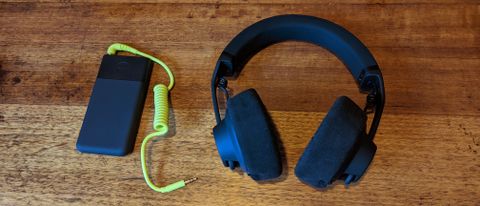TechRadar Verdict
The main selling points of the Studio Wireless+ are somewhat niche – latency-free and lossless wireless audio are great for music and video producers as well as audiophiles, but not so important for everyday music listeners. Even considering this audience, it’s a shame there’s a few quirks present such as a high noise floor, connectivity issues and some poor design choices that set it back. At its price, it doesn’t compete with pure Bluetooth headphones for everyday listeners, and its flaws get in the way of its star feature, ultimately leaving it in an awkward middle ground.
Pros
- +
Lossless, latency-free wireless
- +
Exceptional Bluetooth battery life
- +
Modular design
Cons
- -
High noise floor on 2.4GHz
- -
Better Bluetooth alternatives
- -
A few operational quirks
Why you can trust TechRadar
One-minute review
The TMA-2 Studio Wireless+ from AIAIAI is a unique configuration of the brand’s line of modular headphones, targeted at audiophiles, and video and music creators due to its ability to wirelessly connect via a latency-free, lossless 2.4GHz connection as well as Bluetooth.
Like with the TMA-2 Ninja Tune Edition, the Studio Wireless+ arrives dismantled, with each of its components able to be upgraded, swapped or replaced to your liking. This is somewhat of a novelty, but great if you’d like to customize your drivers or ear cups, or replace them if they break down the line.
Once assembled, the headphones have a rather svelte, black design, although some of this minimalism comes with ease-of-use frustrations like buttons that are a little too finicky. The headband is also much larger than most wireless headphones (to store the wireless tech and large battery needed for it), which can lead to discomfort for those with larger heads.
The headphones ship with a battery-powered wireless transmitter that plugs into any analog audio output (via 3.5mm or 6.35mm port), turning the device it’s attached to into a wireless audio source through AIAIAI’s ‘W+ Link’ technology that transmits via the 2.4GHz band.
As promised, the audio signal via this connection offers practically no latency – ideal for video and audio editing – and doesn’t have the same compression process as Bluetooth. This latter point might be moot for the average listener, unless you’re an audiophile who listens to FLAC files and other lossless media.
Overall, the sound is neutral with decent separation, with subdued extremes in the sub-bass and upper treble range. This doesn’t make for as exciting a listen as Sony’s flagship headphones, but can be good for those seeking a more clinical monitoring of their audio. You can always swap out the drivers if you’d prefer a different profile.
Unfortunately, the lossless nature of the W+ Link tech is somewhat sullied by a high noise floor, meaning that the connection produces a static hiss even when nothing is plugged into it. This can be somewhat remedied with volume tweaks to both the headphones and media source, but those who like to listen loud will have to deal with the noise.
A massive 80-hour battery life is possible if connected via Bluetooth, but this diminishes to just 16 hours on the 2.4GHz band. This, coupled with the 30-hour battery life of the wireless transmitter, means you’ll be charging two devices every few days if you use the latter technology.
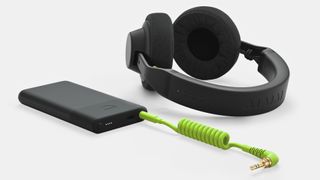
AIAIAI TMA-2 Studio Wireless+ price and release date
- Available now
- $350 / £300 / AU$549
The TMA-2 Studio Wireless+ headphones from AIAIAI were launched in January 2022 for $350 / £300 / AU$549 globally and are available in a single color – black.
Their pricing puts them squarely in line with Sony’s WH-1000XM4 – which TechRadar reckons are the best headphones available today. Despite the price similarity, many of the selling points of these TMA-2 headphones are quite different to Sony’s.
In fact, there’s very little on the market to directly compare them to thanks to their unique feature set, but if all you’re after is an all-round excellent pair of Bluetooth headphones, Sony’s flagship cans are the better buy.
Design
- Modular components
- Pleasant Alcantara ear cups
- Frustrating controls
First and foremost, the TMA-2 Studio Wireless+ is modular by design, as with everything from AIAIAI. This means that the headphones arrive in pieces, individually packaged in the box, and you’ll need to assemble them yourself (don’t worry, the process is dead easy and even oddly satisfying).
The modular design allows users to upgrade and swap out individual components if they so desire – upgrading the speaker drivers, swapping the ear cup material, or even converting them from over-ears to on-ears. This also means that the company can release different versions of the TMA-2 and share certain components between them (as they have done).
While it can be seen as a gimmick, if you’re keen on longevity or customizability in your products, it’s a solid solution. Not only can you replace a single part if it fails (without having to ship it off to the manufacturer), but you can also pick and choose each component to your liking.
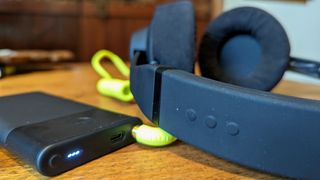
With that said, two of the components in the box are unique to this TMA-2 configuration: the H10 headband and the X01 transmitter. You’ll need both of these for the Studio Wireless+ flagship feature (2.4GHz transmission; more on this later) to function. You can buy both of these components as a pair, but they’re not sold separately.
Once assembled, the Studio Wireless+ resemble the rest of the TMA-2 range – a minimal, black aesthetic with controls, indicator lights, and ports relatively well hidden. The bulk of the unit is coated in either silicon or a rubberized plastic, both of which are massive fingerprint attractors.
The H10 headband is bulkier than other TMA-2 offerings, likely due to it housing the wireless tech and the larger battery needed to power it. We also found it rather stiff around our (admittedly large) head which, combined with its size, made for a clamping sensation that was fatiguing after a short while.
In contrast, the E08 Alcantara ear cups were incredibly soft and comfortable, allowing our ears to breathe and providing adequate cushioning. Those with small to medium-sized heads will likely find the headphones rather comfortable overall (albeit a touch heavy) but be warned, fellow bigheads, as you will feel the crush.
On the control front, there’s three buttons on the exterior of the headband performing the typical duties – power on/off, pause/play, volume up/down, etc – and another switch on the interior flips it between Bluetooth and 2.4GHz wireless modes. This switch, along with the tiny indicator light, show blue when in Bluetooth mode or white for wireless, which is a nice quality-of-life feature for quickly referencing the current mode.
The buttons on both the headband and transmitter are of a similar design and present similar problems. They’re silicon-coated, don’t have much travel and require a rather firm press. This is great for avoiding accidental presses, but their stiffness requires a bit too much force for comfort, making the process for powering on and off (holding for three seconds) especially finicky. There’s also no auto-powering off for either unit, so the process is unavoidable.
As with other TMA-2 models, the USB-C charging port for the headphones is in a rather tricky (albeit neatly hidden) location – on the inside of the headband next to one of the cables that connect the drivers to the band. Thankfully, AIAIAI is now providing a right-angle USB cable for charging, and this helps in negating the difficulty of plugging it in.
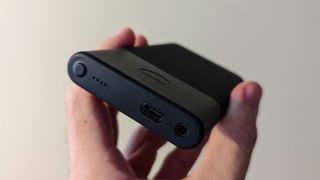
Anyone unfamiliar with this product would assume the X01 transmitter is actually a power bank, sharing a near-identical design with most portable chargers on the market. It’s mostly coated in the same rubberized plastic that covers parts of the headphones, presumably to allow for better grip when placed on a surface, and has very few features apart from its single button, four indicator lights, and USB-C and 3.5mm ports.
Provided with the transmitter is a neon green coiled audio cable and a 3.5mm-to-6.35mm adapter. This arrived very tightly bound and is permanently warped as a result. This warping, in combination with the stiff cable and light weight of the transmitter, negates the function of the coiled cable as the transmitter will sit wherever the cable wants it to rather than allowing the user to place it in varying positions and distances from the audio source.
Along with a coiled audio cable (C02), a soft carry pouch (A01) is provided in the box, allowing you to store your headphones, transmitter and cabling to keep it free of dust and scratches.
Audio performance
- Lossless audio
- High noise floor
- Well-balanced, rich audio
Before we tackle how the headphones are meant to sound, there’s one issue that needs raising – noise floor. When the headphones are connected via 2.4GHz to the wireless transmitter, there is a hissing static apparent in the output. This is present when media is playing or paused, and even when the transmitter has no audio cable plugged into it. So the noise floor exists inherently in the transmitter-headphone connection.
AIAIAI has acknowledged the issue and has a dedicated troubleshooting page for the noise floor, but its suggested solution is essentially to just lower the volume. This method does work in part – lowering the volume directly on the headphones will reduce the noise to unnoticeable levels, and then increasing the volume on your audio source device can counteract the volume drop… to an extent.
We tested this with our Apple Mac Mini (M1) as well as a synthesizer and dedicated media player, and found the solution did work but at the expense of lowering the ‘maximum’ volume available. Even with the source devices outputting their maximum level, the final volume in the headphones wasn’t very loud. There shouldn’t be any issues while listening at low-to-moderate volume levels, but those that enjoy listening at louder volumes will have to deal with a bit of noise.
While we hope that something can be done to remedy the issue in a firmware update, we suspect the noise is intrinsic to the particular technology being used and can’t be fixed in this way.
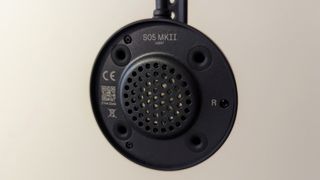
The flagship feature of these headphones is its ability to switch between a Bluetooth connection and a wireless 2.4GHz connection (dubbed W+ Link), the latter promising almost no latency (16ms) and the ability to stream uncompressed audio up to 1500kbps. For reference, FLAC files encoded from CD audio (44.1kHz/16-bit) have a bitrate of 1411kbps.
There’s certainly a technical difference in the audio quality between streaming via Bluetooth or 2.4GHz, but this depends entirely on the source material. A ‘normal’ quality stream via Spotify won’t sound all too different between modes as the source is already compressed, but a FLAC file will (in theory) exhibit better dynamics as they won’t be ‘crushed’ by the compression process of streaming via Bluetooth.
We tested this out by directly comparing FLAC and 320kbps MP3 files from The Lifted Index’s delightful ambient album Sedna. On the track To Look Up At The Cold Sky, we noticed the wavering of the reverb and other ambiences more prominently in the glitching, stuttering intro in the FLAC file, and we found the plodding main guitar refrain to have slightly better separation from the other elements in its frequency range.
With that said, the codecs used to compress and decompress audio in Bluetooth transmissions are increasingly improving and the gap is closing. For the most part, audiophiles and other listeners that are already familiar with lossless playback and cabled listening are the intended audience for the hi-res format, and much of the nuance retained by lossless audio is indiscernible in a blind test, much less if you aren’t directly comparing it side-by-side to a compressed file as we were.
Listening to Gone by UZ (featuring Kevin Flum), the track’s trap hi-hats sizzle and soar, but remain separated from the high-end content of the buzzing bass synth and horns, although the upper treble lacks some air and presence overall. The same is true of the sub-bass, with much of the sub that typically dominates the drops feeling subdued, perhaps due in part to the lack of seal provided by the Alcantara ear cups.
While the suppressed highs and lows make for a less exciting listen than something like Sony’s WH-1000XM4, the overall balance feels more neutral and makes for a more clinical profile with decent (but not exceptional) separation. The sound clarity won’t match audiophile-grade cans or dedicated studio monitors, but it’s a step above much of the wireless headphone competition.
There’s no active noise-cancelling present in these cans, and the passive isolation is quite minimal due to the Alcantara ear cups not creating as strong a seal as pleather or other materials would in its place. This latter point, as we’ve touched on, reduces the overall presence of bass frequencies as the space enclosed by the cups isn’t acting as efficiently as its own passive bass driver. This same phenomenon is typically how in-ear headphones are able to create immense bass from such tiny drivers.
Battery life and connectivity
- Both Bluetooth and 2.4GHz
- Wireless offers hi-res with no latency
- 80 hours Bluetooth, 16 hours wireless
As we’ve pointed out, the TMA-2 Studio Wireless+ features two types of connection, as well as the option to listen cabled. They use 2.4GHz wireless (one of the frequencies used by most modem routers) as well as Bluetooth 5.0. It’s a shame to see that this isn’t the latest standard for Bluetooth, and down the line it may miss out on support for certain codecs, but it’s still sufficient for the vast majority of use cases.
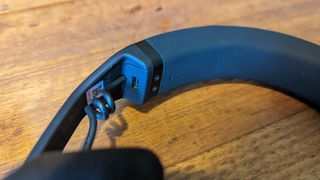
The low latency (specifically, 16ms) of the 2.4GHz connection is one of the key advantages of this medium, and here the Studio Wireless+ performs magnificently. Testing out both Ableton Live and Adobe Premiere Pro for audio and video editing respectively, we noticed no discernible lag between the playhead and the audio landing in our ears. The same cannot be said for using these programs with Bluetooth.
For everyday music listening, latency is a non-issue. You won’t need to worry about the sound arriving at your ears 100-200ms behind the source material that’s playing it. For music or video makers, however, it’s a huge boon. You can rely on the timing that you hear, allowing you to cut shots to a beat or monitor yourself as you play an instrument along to the track, and all of this without a cable getting in the way.
Another perk produced by the W+ Link tech is that you can transform devices that only have an analog audio output into wireless media sources. Whether this be instruments, amplifiers or other hi-fi and AV kit, these headphones can bring them into the modern age.
This 2.4GHz connection isn’t without its snags though; it comes with a high noise floor (as we’ve mentioned) and the connection isn’t two-way. This means that you won’t be able to control playback or volume on your device via your headphone’s buttons, and the integrated microphone won’t work.
We also noticed that, as we left the range of the transmitter, the headphones would click and pop uncomfortably (rather than just cut out as most Bluetooth connections do). The guide tone that signals you're connected would occasionally play out of nowhere too, even with neither the headphones nor transmitter shifting location at all.
On top of this, the battery life in the 2.4GHz mode is a fraction of that in Bluetooth – the headphones offer 16 hours of playback in this mode, compared to over 80 in Bluetooth (which we have to say, is tremendous for wireless headphones). The transmitter itself is estimated to have 30 hours in its tank, so if you’re using the headphones in their 2.4GHz mode a lot, be prepared to charge two items every few days.
Should I buy the AIAIAI TMA-2 Studio Wireless+?

By them if...
You’re a content creator seeking wireless audio
If you make music or video and are sick of latency and lossy audio from Bluetooth headphones, then these cans are one of the only wireless solutions to this problem.
You want to make an analog output wireless
One of the boons of this system is that the wireless transmitter can be plugged into anything with an analog audio output (3.5mm or 6.35mm). This means that devices that don’t support any form of wireless transmission can be converted.
Don't buy them if...
You just want all-round solid Bluetooth headphones
While the TMA-2 Studio Wireless+ perform solidly as Bluetooth headphones, their pricing takes into account their flagship feature of 2.4GHz wireless transmission. This means that competitors at the same price (like Sony’s WH-1000XM4) present much better value overall if Bluetooth is all you’re after.
You need noise-cancelling or other modern features
These headphones don’t sport many of the features common to modern Bluetooth cans, including noise-cancelation, automation, voice assistance and more – so if you’re after the mod cons, look elsewhere.
You want to use 2.4GHz at loud volumes
As we’ve mentioned throughout the review, the 2.4GHz connection has an especially high noise floor when playing at higher volumes, which can get fatiguing and irritating over time, and diminishes clarity.
